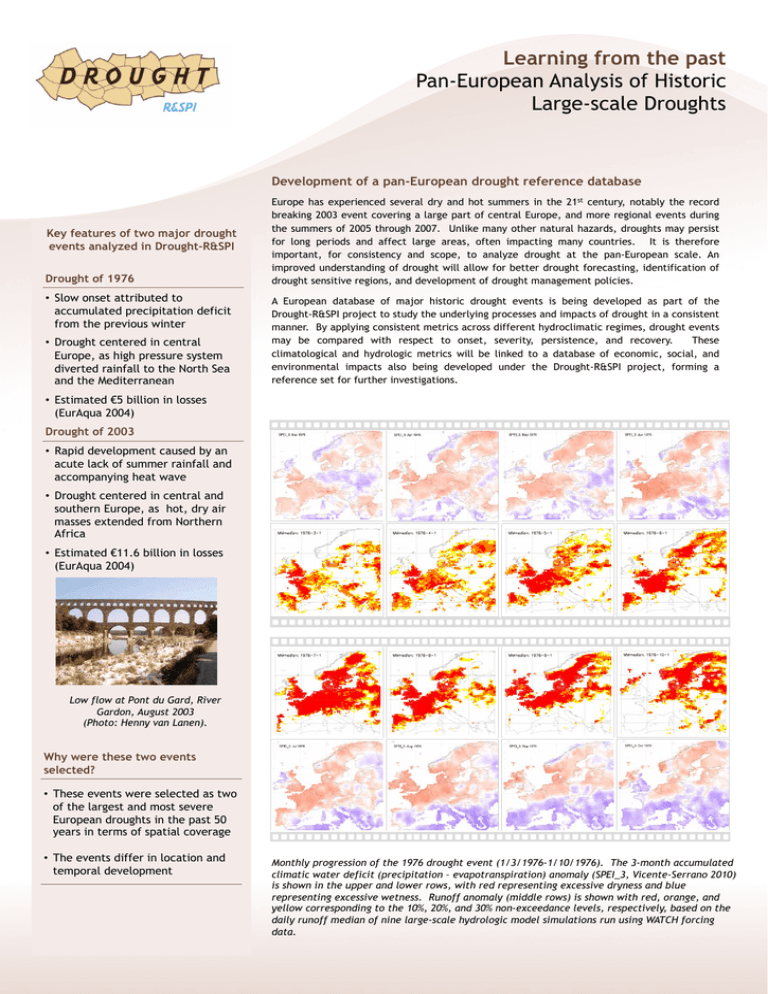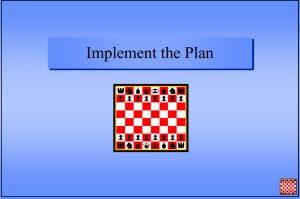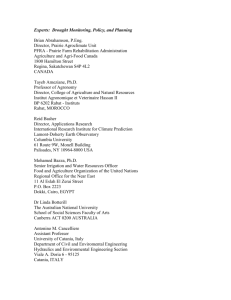Learning from the past Pan-European Analysis of Historic Large-scale Droughts
advertisement

Learning from the past Pan-European Analysis of Historic Large-scale Droughts Development of a pan-European drought reference database Key features of two major drought events analyzed in Drought-R&SPI Drought of 1976 • Slow onset attributed to accumulated precipitation deficit from the previous winter • Drought centered in central Europe, as high pressure system diverted rainfall to the North Sea and the Mediterranean Europe has experienced several dry and hot summers in the 21st century, notably the record breaking 2003 event covering a large part of central Europe, and more regional events during the summers of 2005 through 2007. Unlike many other natural hazards, droughts may persist for long periods and affect large areas, often impacting many countries. It is therefore important, for consistency and scope, to analyze drought at the pan-European scale. An improved understanding of drought will allow for better drought forecasting, identification of drought sensitive regions, and development of drought management policies. A European database of major historic drought events is being developed as part of the Drought-R&SPI project to study the underlying processes and impacts of drought in a consistent manner. By applying consistent metrics across different hydroclimatic regimes, drought events may be compared with respect to onset, severity, persistence, and recovery. These climatological and hydrologic metrics will be linked to a database of economic, social, and environmental impacts also being developed under the Drought-R&SPI project, forming a reference set for further investigations. • Estimated €5 billion in losses (EurAqua 2004) Drought of 2003 • Rapid development caused by an acute lack of summer rainfall and accompanying heat wave • Drought centered in central and southern Europe, as hot, dry air masses extended from Northern Africa • Estimated €11.6 billion in losses (EurAqua 2004) Low flow at Pont du Gard, River Gardon, August 2003 (Photo: Henny van Lanen). Why were these two events selected? • These events were selected as two of the largest and most severe European droughts in the past 50 years in terms of spatial coverage • The events differ in location and temporal development Monthly progression of the 1976 drought event (1/3/1976-1/10/1976). The 3-month accumulated climatic water deficit (precipitation – evapotranspiration) anomaly (SPEI_3, Vicente-Serrano 2010) is shown in the upper and lower rows, with red representing excessive dryness and blue representing excessive wetness. Runoff anomaly (middle rows) is shown with red, orange, and yellow corresponding to the 10%, 20%, and 30% non-exceedance levels, respectively, based on the daily runoff median of nine large-scale hydrologic model simulations run using WATCH forcing data. Learning from the past Pan-European Analysis of Historic Large-scale Droughts Progression of the 2003 drought event at 4 month intervals (4/2003-12/2003). Red cells represent excessive dryness accumulated over the preceding 6 months, measured by Standardized Precipitation-Evapotranspiration Index (SPEI). Blue cells indicate an excess of wetness. The 1976 and 2003 European Drought Events Drought-R&SPI Project participants responsible for analysis of large scale drought University of Oslo (UiO) [Lead], Norway ETH Zurich (ETH), Switzerland University of Freiburg (ALU-FR), Germany Wageningen University (WU), The Netherlands Flier prepared by James Stagge (UiO), Lena Tallaksen (UiO), Kerstin Stahl (ALU-FR), Lukas Gudmundsson (ETH), and Anne van Loon (WU). References EurAqua (2004) Discussion Document: Towards a European Drought Policy. Fischer, E.M., Seneviratne, S.I., Vidale, P.L., Lüthi, D. & Schär, C. (2007) Soil moisture-atmosphere interactions during the 2003 European summer heat wave. J. Climate 20, 5081-5098. Perry, A. (1980) Dominant Pressure Patterns. In: Atlas of Drought in Britain, J.C. Doornkamp, K.J. Gregory, and A.S. Burn (Editors). Institute of British Geographers, pp. 14. Schär, C. & G. Jendritzky (2004) Hot news from summer 2003. J. Climate 432, 559-560. Stahl, K. & Hisdal, H. (2004) Drought hydroclimatology. In: Hydrological Drought – Processes and Estimation Methods for Streamflow and Groundwater, L.M. Tallaksen and H.A.J. van Lanen (Editors). Development in Water Sciences, pp. 19-51. Vicente-Serrano, S.M., Beguería, S. & López-Moreno, J.I. (2010) A Multiscalar Drought Index Sensitive to Global Warming: The Standardized Precipitation Evapotranspiration Index. J. Climate 23, 1696-1718. The 1976 and 2003 drought events allow a comparison between an event with a slowly accumulated moisture deficit (1976) and an event with a more acute lack of summer rainfall, with an accompanying heat wave (2003). The 1976 event was brought about by a relatively dry, mild winter with below average precipitation. This precipitation deficit, centered in France, the UK and Scandinavia, accumulated slowly over several months and grew into a severe summer drought across Central Europe when abnormally high pressure centres diverted much of the rain-bearing depressions either far north or south into the Mediterranean region (Perry 1980). Abnormally hot, dry conditions continued until cold air was advected over Scandinavia in August, breaking the pattern and forming a large, low pressure zone over the Continent. In 2003, a high pressure system developed over western Europe, blocking moist air from the west and allowing warm, dry air masses from northern Africa to extend northwards into Europe. This resulted in a summer heat wave, with mean June-August temperatures exceeding the 1961-90 mean by over 5° C (Schär et al. 2004). Abnormally high temperatures, in addition to an early spring greening and positive atmospheric-soil moisture feedback, contributed to a significant increase in evapotranspiration and drought conditions across most of central and southern Europe (Fischer et al. 2007). Record low streamflow and groundwater levels were reported in addition to record high water temperatures for several European rivers (Stahl and Hisdal 2004). Other Major European Drought Events Period Region/Countries Affected 1976-­‐77 Western Europe 1981-­‐82 Iberian Peninsula (Portugal, Spain, Southern France, Corsica, Italy) 1988-­‐91 1992-­‐94 Mediterranean Region (Portugal, Spain, Southern France, Italy, Albania, Greece) Eastern Europe (Germany, Denmark, Poland, Lithuania, Hungary, Former Yugoslavia, Ukraine, Moldova) 1992-­‐95 Spain 2000 Central Europe (Romania, Hungary, Poland, Bulgaria, Greece, Former Yugoslavia, Czech Rep, Turkey, Germany) 2003 Europe (Romania, Hungary, Poland, Bulgaria, Greece, Former Yugoslavia, Czech Rep, Austria, Switzerland, Italy, Germany, Belgium, Denmark, Netherlands, Norway, UK, France, Spain, Portugal) Based on EurAqua (2004)





